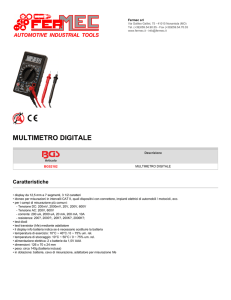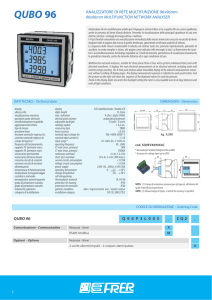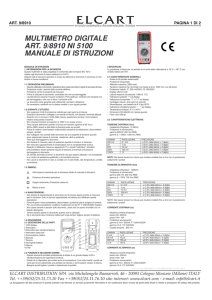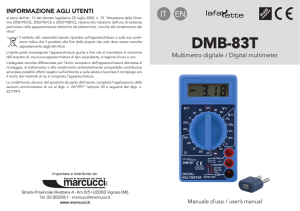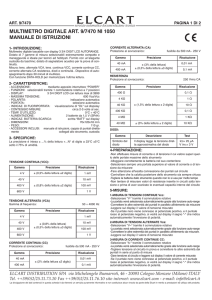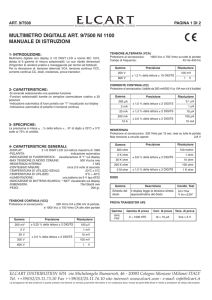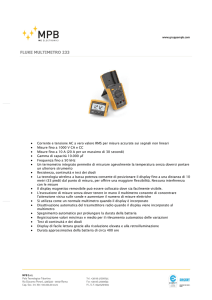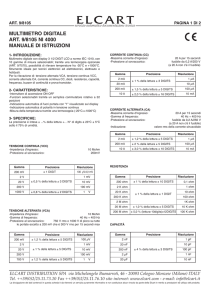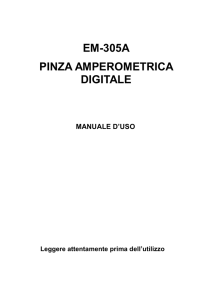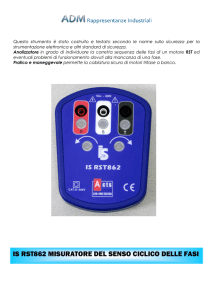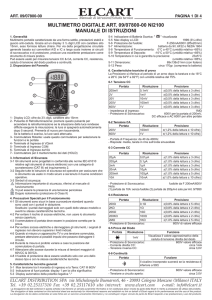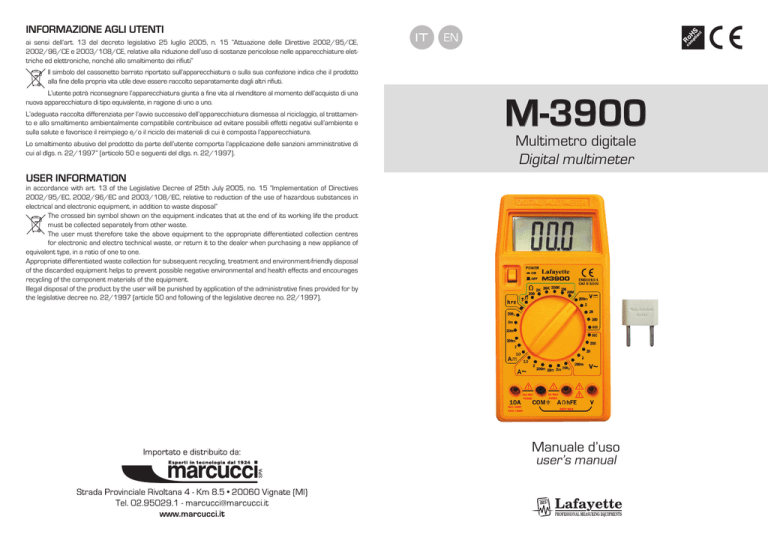
INFORMAZIONE AGLI UTENTI
ai sensi dell’art. 13 del decreto legislativo 25 luglio 2005, n. 15 ”Attuazione delle Direttive 2002/95/CE,
2002/96/CE e 2003/108/CE, relative alla riduzione dell’uso di sostanze pericolose nelle apparecchiature elettriche ed elettroniche, nonché allo smaltimento dei rifiuti”
Il simbolo del cassonetto barrato riportato sull’apparecchiatura o sulla sua confezione indica che il prodotto
alla fine della propria vita utile deve essere raccolto separatamente dagli altri rifiuti.
L’utente potrà riconsegnare l’apparecchiatura giunta a fine vita al rivenditore al momento dell’acquisto di una
nuova apparecchiatura di tipo equivalente, in ragione di uno a uno.
L’adeguata raccolta differenziata per l’avvio successivo dell’apparecchiatura dismessa al riciclaggio, al trattamento e allo smaltimento ambientalmente compatibile contribuisce ad evitare possibili effetti negativi sull’ambiente e
sulla salute e favorisce il reimpiego e/o il riciclo dei materiali di cui è composta l’apparecchiatura.
Lo smaltimento abusivo del prodotto da parte dell’utente comporta l’applicazione delle sanzioni amministrative di
cui al dlgs. n. 22/1997” (articolo 50 e seguenti del dlgs. n. 22/1997).
M-3900
Multimetro digitale
Digital multimeter
USER INFORMATION
in accordance with art. 13 of the Legislative Decree of 25th July 2005, no. 15 ”Implementation of Directives
2002/95/EC, 2002/96/EC and 2003/108/EC, relative to reduction of the use of hazardous substances in
electrical and electronic equipment, in addition to waste disposal”
The crossed bin symbol shown on the equipment indicates that at the end of its working life the product
must be collected separately from other waste.
The user must therefore take the above equipment to the appropriate differentiated collection centres
for electronic and electro technical waste, or return it to the dealer when purchasing a new appliance of
equivalent type, in a ratio of one to one.
Appropriate differentiated waste collection for subsequent recycling, treatment and environment-friendly disposal
of the discarded equipment helps to prevent possible negative environmental and health effects and encourages
recycling of the component materials of the equipment.
Illegal disposal of the product by the user will be punished by application of the administrative fines provided for by
the legislative decree no. 22/1997 (article 50 and following of the legislative decree no. 22/1997).
Manuale d’uso
user’s manual
M-3900 - Manuale d’uso
Manuale d’uso - M-3900
1. INTRODUZIONE
•
•
•
•
Elevata precisione
Ampio display LCD
Altezza cifre sul display 25mm
Selettore rotativo a 30 posizioni per la selezione delle FUNZIONI e delle GAMME operative, grazie
al quale viene garantita la massima semplicità operativa.
• Jack colorati con sistema di protezione completa dei puntali.
• Indicazione di batteria scarica.
2. SPECIFICHE GENERALI
1– Display: tipo LCD 3 ½ digits con lettura massima 1999
2– Rateo di aggiornamento misura: 2-3 secondi
3– Indicazione fuori gamma: sul display appare l’indicazione “1”
4– Indicazione automatica polarità negativa,
5– Indicazione batteria scarica: sul display appare il simbolo della batteria.
6– Protezione completa contro sovraccarichi od errori di misura.
7– Temperatura operativa: da 0°C a 40°C, 0-75%RH,
8– Temperatura di stoccaggio: -10°C-50°C, 0-75%RH
9– Alimentazione tramite singola batteria da 9V IEC 6F22, NEDA 1604, JIS 006P.
10–Dimensioni: 172 x 88 x 36mm (LxPxH)
11–Peso: Circa 210g inclusa batteria
12–Accessori: coppia di puntali, adattatore multifuzione e manuale d’uso.
Gamma
Risoluzione
Precisione
200mV
100uV
± (1.2% della lettura + 5 digits)
2V
1mV
20V
10mV
200V
100mV
600V
1V
ITA
2 - Tensione alternata ACV
Il multimetro digitale modello M-3900 è uno strumento di elevata precisione funzionamento a batteria e dotato di un ampio display LCD da 3 ½ digits.
± (1.0% della lettura + 5 digits)
± (1.2% della lettura + 5 digits)
Impedenza di ingresso: 10MΩ
Gamma di frequenza: 40-400Hz
3 - Corrente continua DCA
Gamma
Risoluzione
200uA
0.1uA
2mA
1uA
20mA
10uA
200mA
100uA
2A
1mA
10A
10mA
Precisione
± (1.8% della lettura + 2 digits)
± (2.0% della lettura + 2 digits)
± (2.0% della lettura + 10 digits)
Caduta di tensione durante la misura: 200mV
Fusibile 1: tipo rapido F2A/600V(A Ω hFE)
Fusibile 2: tipo rapido F10A/600V(10A)
3. SPECIFICHE ELETTRICHE
La precisione delle misure viene garantita ±(% della lettura + numero di digits significativi) per un
anno, alla temperatura di 23°C ±5° RH<75%.
1– Tensione continua DCV
4 - Corrente alternata ACA
Gamma
Risoluzione
Gamma
Risoluzione
Precisione
200uA
0.1uA
200mV
10uV
± (0.5% della lettura + 3 digits)
2mA
1uA
20mA
10uA
200mA
100uA
2A
1mA
10A
10mA
2V
1mV
20V
10mV
200V
100mV
600V
1V
Impedenza di ingresso: 10MΩ su tutte le gamme
± (0.8% della lettura + 2 digits)
± (1.0% della lettura + 2 digits)
Precisione
± (1.8% della lettura + 3 digits)
± (2.0% della lettura + 5 digits)
± (2.5% della lettura + 10 digits)
Caduta di tensione durante la misura: 200mV
Gamma di frequenza: 40-400Hz
Fusibile 1: tipo rapido F2A/600V(A Ω hFE)
Fusibile 2: tipo rapido F10A/600V(10A)
1
Manuale d’uso - M-3900
5. METODO DI MISURA
5 - Misura di resistenza Ohm Ω
Gamma
Risoluzione
Precisione
±(1% della lettura + 10 digits)
200Ω
100mΩ
2KΩ
1Ω
20KΩ
10Ω
200KΩ
100Ω
2MΩ
1kΩ
20MΩ
10kΩ
±(1%della lettura + 4 digits)
±(1% della lettura + 10digits)
4. PRECAUZIONI E PREPARAZIONE ALLA MISURA
1– Durante la fase di misura non superare i limiti di seguito riportati:
Gamma di misura
200mV
2-600V
Terminali
V COM
Ingresso massimo
hFE
A Ω hFE COM
2A
10A
Note:
a– Se la tensione da misurare è sconosciuta, si consiglia di impostare lo strumento sulla gamma
di misura più elevata.
b– Se sul display appare l’indicazione “1” di fuori gamma, portare il selettore di gamma su di un
valore di misura più elevato.
c– Non tentare di eseguire misure con valori di tensione superiori ai 600V, in quanto esiste il
pericolo di shock elettrico o di danno allo strumento.
600V
250V DC/AC
2A
10A COM
1– Impostare il selettore di gamma sulla posizione di misura desiderata.
2– Collegare il puntale NERO alla presa COM dello strumento ed il puntale ROSSO al terminale di
ingresso “V”.
3– Collegare i puntali ai punti di misura e leggere il valore misurato con la relativa polarità direttamente sul display LCD dello strumento.
250V
OHM
Diodi
5.1 MISURA DI TENSIONI DCV & ACV
10A
2– Verificare che la batteria sia correttamente inserita e connessa alla apposita clips.
3– Prima di eseguire una misura verificare che i puntali del tester siano integri e che l’isolamento
non presenti screpolature. Eventualmente sostituire immediatamente i puntali.
4– Selezionare la gamma di misura corretta in base al tipo di prova che si intende eseguire.
5– Verificare la posizione di collegamento del puntale rosso in base al tipo di misura che si intende
eseguire.
6– Durante la fase di variazione della gamma di misura, scollegare almeno un puntale dal circuito
sotto misura.
7– Onde scongiurare il pericolo di shock elettrico ed evitare danni allo strumento, non applicare
tensioni superiori ai 600V tra ciascun terminale e terra.
8– Onde evitare il pericolo di shock elettrico, usare la massima cautela quando si opera con tensioni superiori ai 60Vdc o 25Vac.
9– Al termine della fase di misura, spegnere lo strumento. In caso di inutilizzo per lungo tempo
dello strumento, si consiglia di rimuovere la batteria dal suo interno.
10–Non manomettere o smontare lo strumento.
11–Non utilizzare lo strumento in luoghi molto caldi oppure in presenza di elevati tassi di umidità.
Evitare si esporre lo strumento sotto l’influenza diretta dei raggi solari.
5.2 MISURA DI CORRENTE DCA & ACA
1– Collegare il puntale NERO alla presa COM dello strumento ed il puntale ROSSO al terminale
di ingresso “A Ω hFE” il quale è in grado di sopportare misure fino ad un valore di 2A. Oppure
collegare il puntale NERO alla presa COM dello strumento ed il puntale ROSSO al terminale di
ingresso “10 A” per eseguire misure in corrente fino ad un valore massimo di 10A.
2– Impostare il selettore di gamma sulla posizione di misura desiderata.
3– Collegare i puntali ai punti di misura e leggere il valore di corrente misurato con la relativa
polarità direttamente sul display LCD dello strumento.
Note:
a– Se la corrente da misurare è sconosciuta, si consiglia di impostare lo strumento sulla gamma
di misura più elevata.
b– Se sul display appare l’indicazione “1” di fuori gamma, portare il selettore di gamma su di un
valore di misura più elevato.
c– Un valore eccessivo di corrente causa la bruciatura del fusibile di protezione, in tal caso
procedere alla sostituzione del fusibile interrotto con un altro dalle medesime caratteristiche.
d– Nella gamma dei 10A, eseguire misure con un valore massimo di 10A e per un tempo di
misura inferiore ai 10 secondi per ogni 15 minuti in maniera da non provocare danni allo
strumento.
ITA
M-3900 - Manuale d’uso
5.3 MISURA DI RESISTENZA Ω
1– Collegare il puntale NERO alla presa COM dello strumento ed il puntale ROSSO al terminale di
ingresso “A Ω hFE”.
2– Impostare il selettore sulla gamma Ω.
3– Collegare i puntali di misura ai capi della resistenza che si vuole misurare e leggere il valore in
Ω sul display LCD.
Note:
a– La polarità del puntale rosso è positiva “+”
b– A circuito aperto sul display apparirà l’indicazione “1”.
c– Se il valore di resistenza sotto misura eccede il valore impostato tramite il selettore rotativo,
sul display apparirà l’indicazione “1”
5.4 PROVA DIODI E CONTINUITA’
1– Impostare il selettore sulla gamma “
”.
2– Collegare il puntale NERO alla presa COM dello strumento ed il puntale ROSSO al terminale di
ingresso “A Ω hFE”. (nota: La polarità del puntale rosso è positiva).
3– In questa gamma è possibile eseguire il test di continuità, dove nel caso che la resistenza
del circuito sotto misura presenti un valore inferiore ai 30 ±20Ω, si otterrà l’emissione di un
segnale acustico.
4– Per la prova diodi, collegare i puntali ai capi del diodo sotto esame ed interpretare il risultato
della misura nel seguente modo:
Note:
a– A circuito aperto (puntali non connessi o diodo/circuito interrotto) sul display apparirà l’indicazione “1”.
b– Condizioni di prova: Corrente diretta DC circa 1mA. Tensione inversa DC circa 3V.
c– Lo strumento è in grado di visualizzare il valore della tensione inversa, mentre visualizza il
valore “1” in caso di diodo invertito.
5.5 PROVA hFE TRANSISTOR
1– Impostare il selettore funzioni sulla posizione “hFE”.
2– Utilizzare il connettore adattatore multifunzione collegandolo tra i terminali “COM” e “A Ω hFE”.
3– Verificare il tipo di transistore PNP o NPN.
4– Inserire i terminali del transistor negli appositi inserti contrassegnati come E B C dell’adattatore multifunzione.
5– Sul display LCD del tester apparirà il valore hFE del transistore sotto esame.
Note:
Condizioni di prova: Corrente di base circa 10uA, Vce circa 2.8V.
Manuale d’uso - M-3900
6. SOSTITUZIONE BATTERIA E FUSIBILI
1– L’operazione di sostituzione della batteria e dei fusibili dovrà essere eseguita solo con i puntali
scollegati dal circuito di misura.
2– Per aprire il coperchio inferiore dello strumento svitare l’apposita vite di blocco.
3– Lo strumento è alimentato tramite un singola batteria da 9V (IEC 6F22, NEDA 1604, JIS006P). Scollegare la batteria scarica ed inserire una nuova batteria, facendo attenzione a
non forzare la clip e relativi cavetti.
4– Lo strumento è protetto da due fusibili di tipo rapido (Fusibile 1: F2A/600V e Fusibile 2:
F10A/600V di tipo 5x20).
5– Al termine della sostituzione della batteria o dei fusibili di protezione, richiudere il coperchio
inferiore riavvitando la vite di blocco. Non operare con il coperchio inferiore dello strumento
rimosso.
ITA
M-3900 - Manuale d’uso
M-3900 - Manuale d’uso
Manuale d’uso - M-3900
1. INTRODUCTION
2.
Resolution
Accuracy
200mV
100uV
±(1.2% of reading+ 5 digits)
2V
1mV
20V
10mV
200V
100mV
600V
1V
±(1.2% of reading+ 5 digits)
Accuracy
±(1.0% of reading+ 5 digits)
Input impedance: 1OMΩ
Frequency range: 40- 400Hz
GENERAL SPECIFICATION
1– Display: 3-Y.digits LCDwith a maximum reading of 1999.
2– Measurement rate: updates 2-3/sec.
3– Over range indication: “1” figure only in the display
4– Automatic negative polarity indication.
5– The “ ” operating voltage.
6– Full range over load protection.
7– Operating temperature: 0°C -40°C, D-75% RH. Storage temperature: -10°C-50°C, 0-75% R.H.
8– Power: Single standard 9V battery IEC 6F22,NEDA 1604, JIS 006P.
9– Dimensions: 172L*88W*36Hmm.
10–Weight: approx 210g (induding battery)
11–Accessories: test leads (pair), mu ifuction
3.
Range
ENG
2 - ACV
This Digital Multimeter is a oompact precision, battery operated, LCD display 3-Y. digits Digital
Instrument. Superiority:
• High accuracy
• Large LCD display
• Digital height 25mm
• Single 30 position rotary switch for FUNCTION and RANGE selection, allows fast and oonvenient
operation.
• Colored indication jack with fully protection test leads.
• Lower power indication
ELECTRICAL SPECIFICATIONS
Accuracy is given as ± (% of reading + number of least significant digits) for one year, at 23°C±5°C
RH<75%
Range
Resolution
200uA
0.1uA
2mA
1uA
20mA
10uA
200mA
100uA
2A
1mA
10A
10mA
±(1.8% of reading+ 2 digits)
±(2.0% of reading+ 2digits)
±(2.0% of reading+ 10 digits)
Measuring voltage drop: 200mV
Fuse1: F2N600V (A Ω hFE)
Fuse2:F10JV600V(10A)
4 - ACA
1– DCV
Range
3 - ADC
Resolution
Accuracy
Range
Resolution
±(0.5% of reading+ 3 digits)
200uA
0.1uA
2mA
1uA
20mA
10uA
200mA
100uA
2A
1mA
10A
10mA
200mV
100uV
2V
1mV
20V
10mV
200V
100mV
600V
1V
Input impedance: 1OMΩ on all range
±(0.8% of reading+ 2 digits)
±(1.0% of reading+ 2 digits)
Accuracy
±(1.8% of reading+ 3 digits)
±(2.0% of reading + Sdigits)
±(2.5% of reading+ 10 digits)
Measuring voltage drop: 200mV
Frequency range: 40 -400Hz
Fuse1: F2A/600V(A Ω hFE)
Fuse2: F10N600V(10A)
1
M-3900 - Manuale d’uso
Manuale d’uso - M-3900
5. METHOD OF MEASUREMENT
Range
Resolution
Accuracy
±(1% of reading+ 10 digits)
200Ω
100mΩ
2KΩ
1Ω
20KΩ
10Ω
200KΩ
100Ω
2MΩ
1KΩ
20MΩ
10KΩ
±(1% of reading+ 4 digits)
±(1% of reading+ 10digits)
4. PRECAUTIONS AND PREPARATIONS FOR MEASUREMENT
1– Don’t exceed the input limit shown below:
Function Range
200mV
2-600V
Input terminals
V COM
hFE
A Ω hFE COM
2A
10A
Note:
a– If the voltage to be tested is unknown beforehand, set the Function range switch to the highest range and work down.
b– When only the figure “1” is displayed over range is being indicated and the function range
switch has to be set to a higher range.
c– Never try to measure the voltage above 600V! Although the indication is possible to show,
there is danger of damaging the internal circuitry.
250V
600V
250V DC/AC
2A
10A COM
1– Set the Function range switch at the required position.
2– Connect black test lead to “COM” terminal and red test lead to the ‘V’ input terminal.
3– Connect test leads to measuring point and read the display value the polarity of the red lead
connection will be indicated at the same time as the voltage.
Maximum input
OHM
Diode
5.1 DCV & ACV MASUREMENT
10A
2– Be sure that battery is correctly placed in the battery case and connected to the battery
snap.
3– Inspect the test leads for damaged insulation or exposed metal. Check Test lead continuity.
Damaged leads should be replaced.
4– Select the proper function and range for your measurement.
5– Check the input terminal position for red test lead depends on measurement ranges.
6– Either one of the test leads should be taken off from the circuit under test when changing the
test ranges.
7– To avoid electrical shock or damage to the meter, Do not apply more then 600V between any
terminal and earth ground.
8– To avoid electronic shock, use caution when working above 60VDC or 25VAC rms, such voltage pose a shock hazard.
9– When finished the measurement, switch off the power. Be sure to remove the battery when it
is not used for a long time to avoid leakage problem.
10–Do not tamper with the circuitry to avoid damage.
11–Do not use or store the instrument in a place of direct sunlight, high temperature and high
humidity.
5.2 DCA & ACA MEASUREMENT
1– Connect the black test lead to the “COM” terminal and the red test lead to “AOhFE” terminal
for a maximum of 2A. Or, oonnect the black test lead to the “COM” terminal and the red test
lead to “10A” terminal for a maximum of 10A.
2– Set the function range switch to the required position.
3– Connect test leads to measuring points and read the display value. The polarity at the red test
lead oonnection will be indicated at the same time asthe current.
Note:
a– If the current range is unknown beforehand, set the function range switch to the highest range
and work down.
b– When only the figure “1” is displayed, over range is being indicated and the function range
switch has be set to a higher range.
c– Excessive current will below the fuse that must be replaced.
d– At 10A range, maximum 10A measuring time must be less than 10 seoonds each 15 minutes.
ENG
5 - OHM
M-3900 - Manuale d’uso
Note:
a– The polarity of the red test lead is “+”.
b– When the input is not oonnected, i.e. at open circuit the figure “1” will be displayed for the over
range condition.
c– If the resistance value being measured exceeds the maximum value of the range selected an
over range indication “1” will be displayed and function range switch must be set to a higher
range.
5.4 RESISTANCE MEASUREMENT
1– Set the function range switch to the “
” position.
2– Connect the black test lead to “COM” terminal and red test lead to “A Ω hFE” input terminal
(Note: the polarity of the red test lead is “+”).
3– This range with “AUDIBLE CONTINUITY TEST’ function. Built in buzzer sounds if the resistance between two probes is less than 30±200.
4– Connect the test leads across the diode and read the display value.
Note:
a– When the input is not oonnected, i.e. at open circuit, the figure “1” will be displayed.
b– Test oondition: Forward DC current approx.1mA. Reversed DC voltage approx. 3V.
c– The meter displays the forward vo ge “1” for overload when the diode is reversed.
5.5 TRANSISTOR hFE TEST
1– Set the function range switch to the “hFE” position.
2– Use Multifunction Adapter oonnector to “COM” and “A Ω hFE” terminal.
3– Make sure the transistor is “NPN” or “PNP’’ type.
4– SetTransistor oorrect insert into E.B.C Multifunction Adapter
5– Display reading is approx. transistor hFE value.
Note:
Test condition: Base current approx. 10uA. Vce approx.2.8V
6. BATTERY AND FUSE REPLACEMENT
1– Battery and fuse replacement should only done after the test leads have been disconnected
and power is off.
2– Loosen screws with suitable screwdriver and remove case bottom.
3– The meter is power by a single 9V battery (IEC 6F22, NEDA 1604, JIS 006P). Snap the battery
connector leads to the terminals of a new battery and reinsert the battery into the case top.
Dress the battery leads so that they will not be pinched between the case bottom can case top.
4– The meter is protected fast fuse (Fuse1: F2N600V and Fuse2: F10A/600V) , dimensions
is <D5 x 20mm.
5– Replace the case bottom and reinstall the screws. Never operate the meter unless the case
bottom is fully dosed.
ENG
5.3 RESISTANCE MEASUREMENT
1– Connect black test lead to “COM” terminal and red test lead to the “A Ω hFE” input terminal.
2– Set the function range switch to the 0 range.
3– Connect the test leads across the resistance under measurement andread the display value.
Manuale d’uso - M-3900

